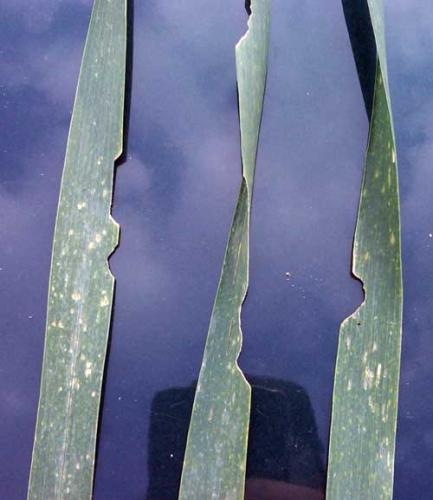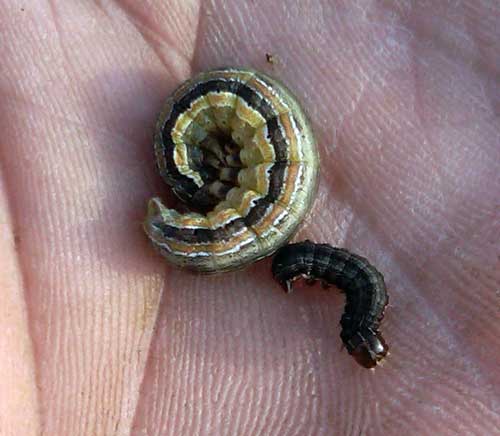Armyworms and rumors of armyworms
Significant armyworm moth capture in Michigan and outbreaks in Ohio and Indiana could mean trouble for Michigan growers of wheat, small grains and corn.
True armyworms do not overwinter in Michigan. Armyworm outbreaks occur when adult moths are blown in from southern states in the spring. The warm winter and early spring experienced in much of the Midwest this year may have contributed to the arrival of armyworm moths in the state by giving them a head start as they made their way north this season. Both Indiana and Ohio are reporting scattered outbreaks of armyworm feeding – some cases are quite severe.
The moths that have arrived here in Michigan over the past few weeks have likely been looking for a mate and laying eggs. Armyworms lay their eggs in grassy areas such as hay fields, grass margins along the edge of fields and in grass crops such as wheat and small grains. By this week, larvae may begin to appear if they have not already, they are likely to still be quite small and eggs may still be hatching. Armyworm feeding injury may be the easiest first sign of a problem. Early feeding is generally along leaf edges of newer leaves as seen Photo 1.

Photo 1. Armyworm feeding typically begins at the leaf margins.
Armyworm larvae are the most active at night and on cloudy, overcast days. Larvae are most easily found and counted during the morning hours in the first few hours of daylight. In the afternoon during sunny days, larvae will seek shelter on the ground under plant debris and in corn they may be found down in the whorl. Scouting in the afternoon will take patient observation, searching through the debris on the ground and shaking plants to find the larvae.

Photo 2. A mid- and late instar larva from 2010.
While armyworm outbreaks can be large, they tend to not be uniform. In 2010 there were many examples of fields at threshold and well below threshold, separated by a mile or less and outbreaks did not occur in every part of the state. The only effective way to determine a need for control is to scout fields for larvae.
The threshold for armyworms in wheat is two or more larvae per square foot at heading. The threshold for corn is 25 percent of plants with two or more larvae per whorl or 75 percent of plants with one larva per whorl.
Do not add an insecticide to fungicide sprays as an insurance measure. Many beneficial insects are at work, especially in wheat fields, keeping other pests such as cereal leaf beetles in check. There are also natural predators of armyworms that help keep low populations in check.
Always read and follow label directions if an insecticide application is warranted and be sure to note the preharvest interval.
The only tried and true way to identify fields in need of an insecticide treatment is to scout. Don’t panic, don’t act on a rumor of what the neighbors are doing, but do send out the scouts.
Related MSU Extension News article: Armyworm moth trap results, Martin Nagelkirk



 Print
Print Email
Email